World’s Largest Stone Buddha
High above the roaring confluence of three mighty rivers—Min River (岷江 Min Jiang), Qingyi River (青衣江 Qingyi Jiang), and Dadu River (大渡河 Dadu He)—sits the planet’s largest stone-carved seated Buddha🎬.

Officially named Jiazhou Lingyun Temple Giant Maitreya Stone Statue (嘉州凌云寺大弥勒石像), and also known as Lingyun Giant Buddha (凌云大佛) or Maitreya Statue (弥勒大像), this giant figure stands 71 meters tall with a 14.7-meter-high head, 7-meter ears, and 8.5-meter-wide feet that could seat over 100 people comfortably.

It was painstakingly carved into the red sandstone cliffs over 90 years, beginning in 713 AD during the Tang Dynasty. Now a UNESCO World Heritage Site, this Maitreya Buddha has watched over the waters for over 1,200 years.
Getting There from Chengdu
The easiest way to visit is to take a high-speed train from Chengdu East Station (成都东站) to Leshan Station (乐山站)— around 1 hour. From there, take Bus 3 to Guichengshan (龟城山), or if you’re driving, head to the North Gate (北门 Běi Mén) of the Leshan Giant Buddha Scenic Area.
3 Ways to Experience the Giant Buddha: Boat, Hike, or Budget Snap
1. Boat Cruise (Best Panoramic Views)
- Ticket Prices:
- Standard: ¥70
- Priority boarding (less crowds/waiting, upper deck access): ¥158 — ideal for families (kids under 1.2 meters free) and those short on time.
- Duration: 25-minute cruise
- Highlights:
- Perfect full-body view of the Buddha
- Stunning perspective of the three rivers merging
- Great photo ops from the open-air deck
2. Hiking (Immersive Close-Up Experience)
- Ticket: ¥80 (free for seniors 60+)
- Opening Hours: 8:00 AM – 5:30 PM
- Duration: 2-3 hours
- Included Sites: Leshan Giant Buddha, Wuyou Temple (乌尤寺 Wūyóu Sì), and Mahaoyamu Cliff Tombs (麻浩崖墓 Máhào Yámù)
- Shuttle Options:
- Single ride: ¥20
- Unlimited rides: ¥30
- Why Hike?
- Walk the historic 333-step Ancient Pilgrim Path
- Touch history – feel the Buddha’s weathered toes
- Heart-pounding views – come face to face with the Buddha along the cliffside plank path
- Explore additional spots like Dragon Pool and Tiger Den
- Boat or Hike?
If you’ve got energy, hike up close for those goosebump moments. But if you’re short on time/stamina, cruise for an effortless dose of wonder.
- Should You Visit the Nearby “Oriental Buddha Park” (东方佛都 Dōngfāng Fódū)?
This site, connected by the back gate of the Leshan Buddha park, is home to over 10,000 Buddha statues, including the world’s largest reclining Buddha (170m). Built later as part of a Buddhist culture preservation effort, it’s a great add-on if you have time or love Buddhist art. But it’s not a must, if you only want the Tang dynasty masterpiece. It requires a separate ticket of ¥80 (about $12) and the visit takes around 1-2 hours extra.
3. Free Viewing (No Ticket Needed)
- Not up for the climb or missed out on boat tickets? Head to Leshan Normal University (乐山师范学院 Lèshān Shīfàn Xuéyuàn) or Huide Sunshine Building (汇得阳光大厦) near Binhe Road (滨河路). Walk along the riverside, and you’ll spot the Buddha’s massive figure peeking from the cliff.
- Ideal For: Quick visits, budget travelers, avoiding crowds
Hiking Route – a step-by-step path to experience the highlights:
- North Gate (北门 Běi Mén) – Starting point
- 333-Step Ancient Pilgrim Path (古拜佛道 Gǔ Bài Fó Dào)
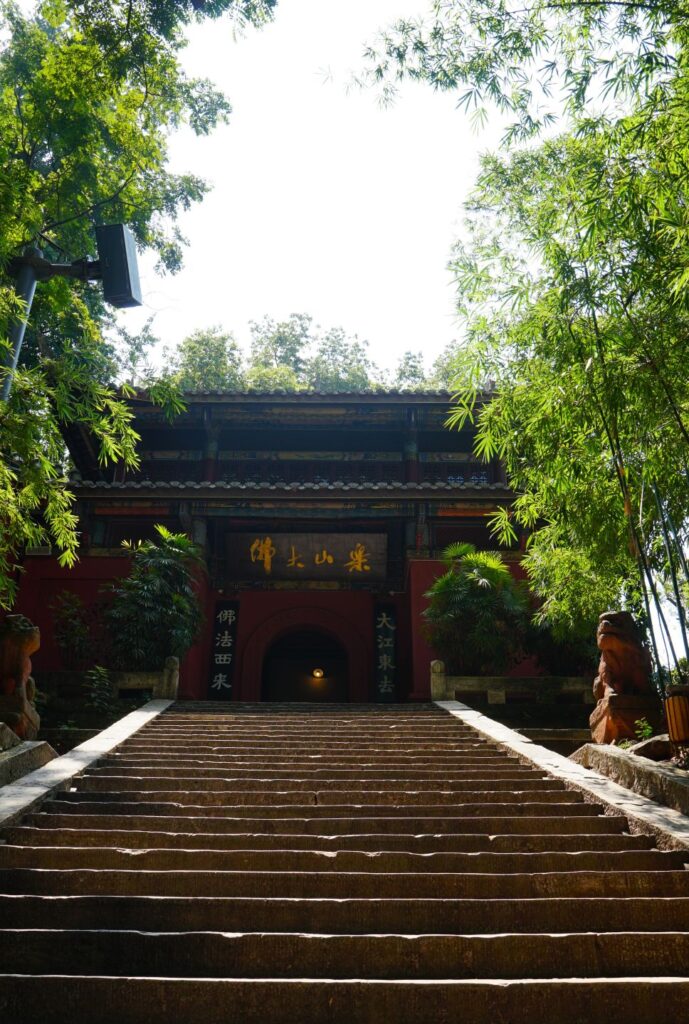
This centuries-old stone staircase was the original pilgrim route—monks and devotees still climb it today as a form of spiritual devotion.
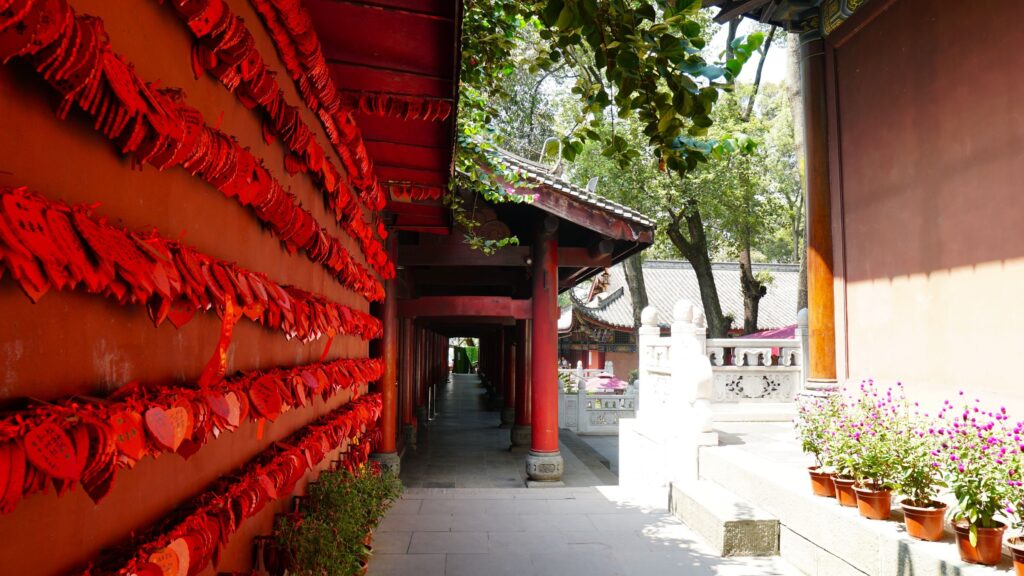
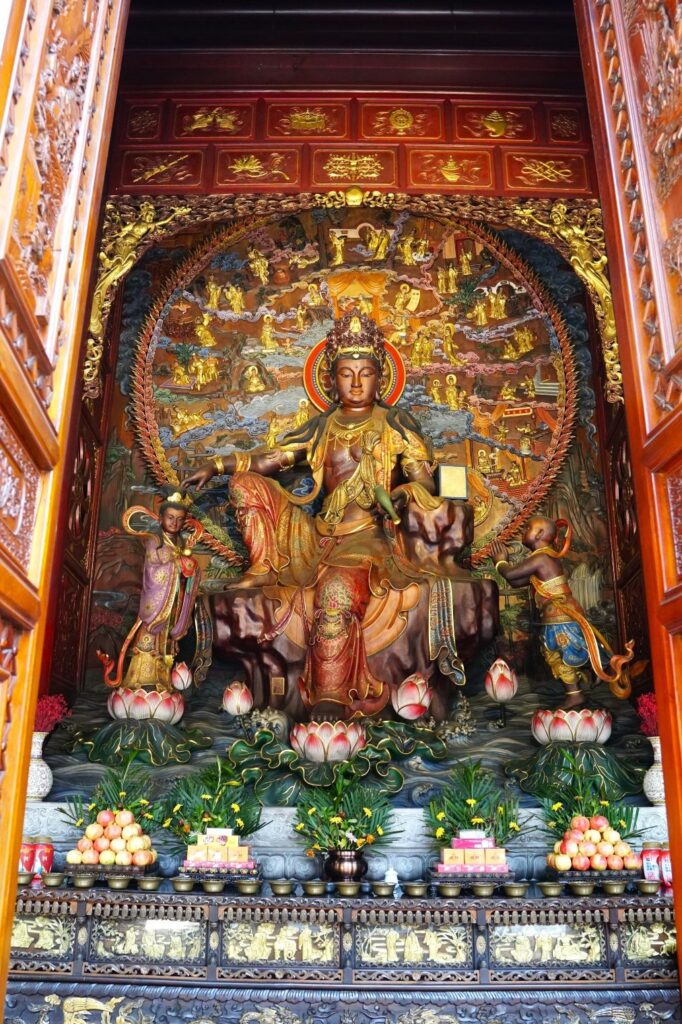
- Dragon Pool (龙湫 Lóng Qiū) & Tiger Den (虎穴 Hǔ Xué)
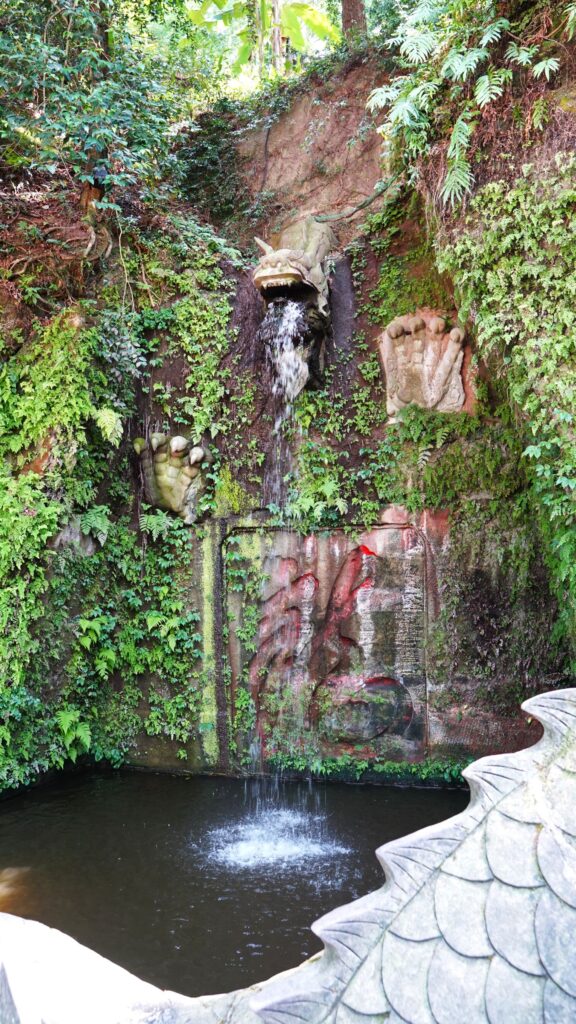
Tiger Den is a legendary cave—some say tigers once lived here, guarding the sacred grounds.
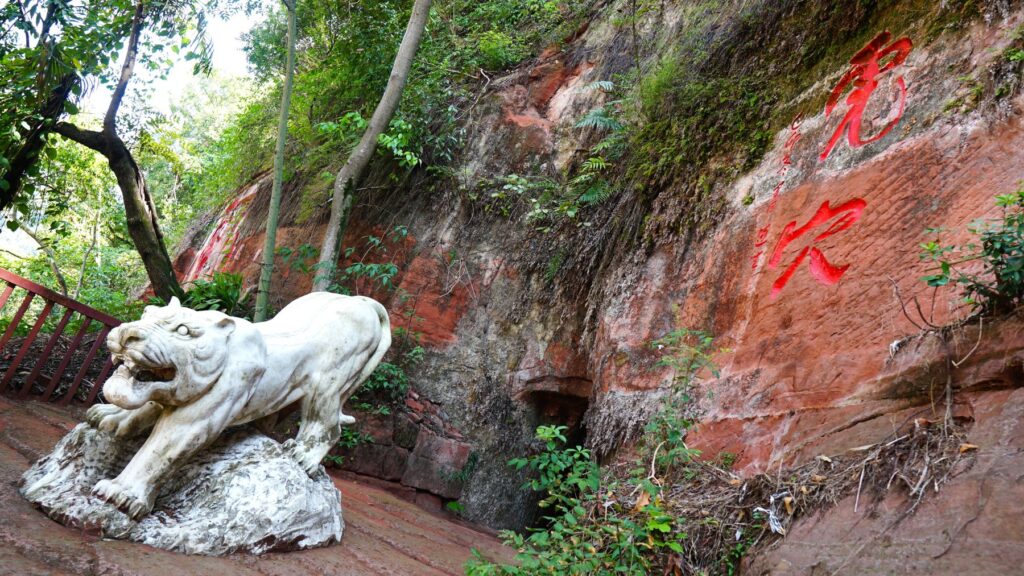
The iron-rich red sandstone made carving easier for ancient artisans, but it’s also soft and prone to erosion—that’s why the Buddha needs constant care.

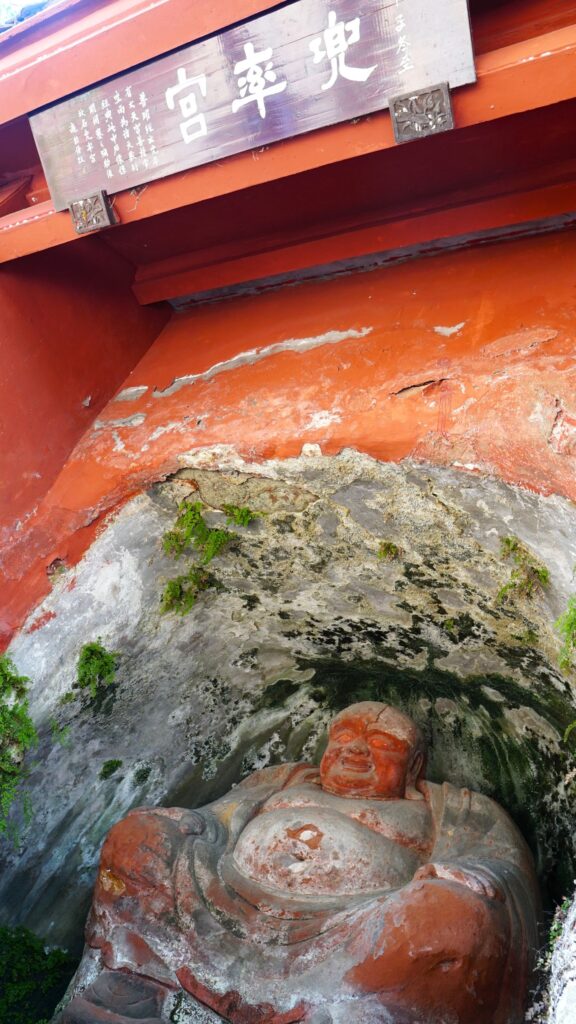
- The Mahao Cliff Tombs (麻浩崖墓)
These burial sites date back to the Han Dynasty (206 BC-220 AD), predating both the Giant Buddha and significant Taoist influence in the area by centuries. Located near later Taoist caves, they offer rare archaeological insight into pre-Buddhist Leshan.
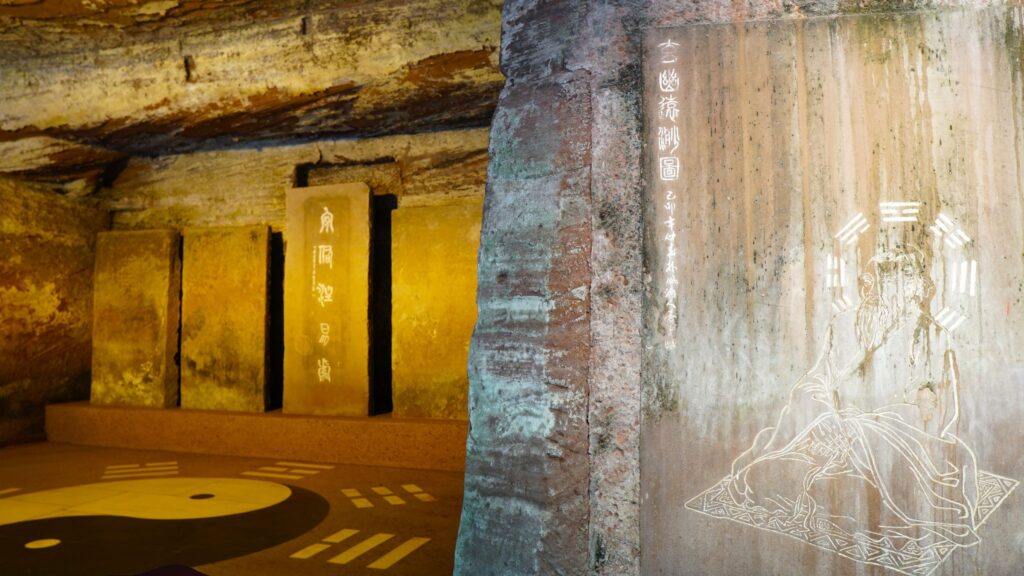
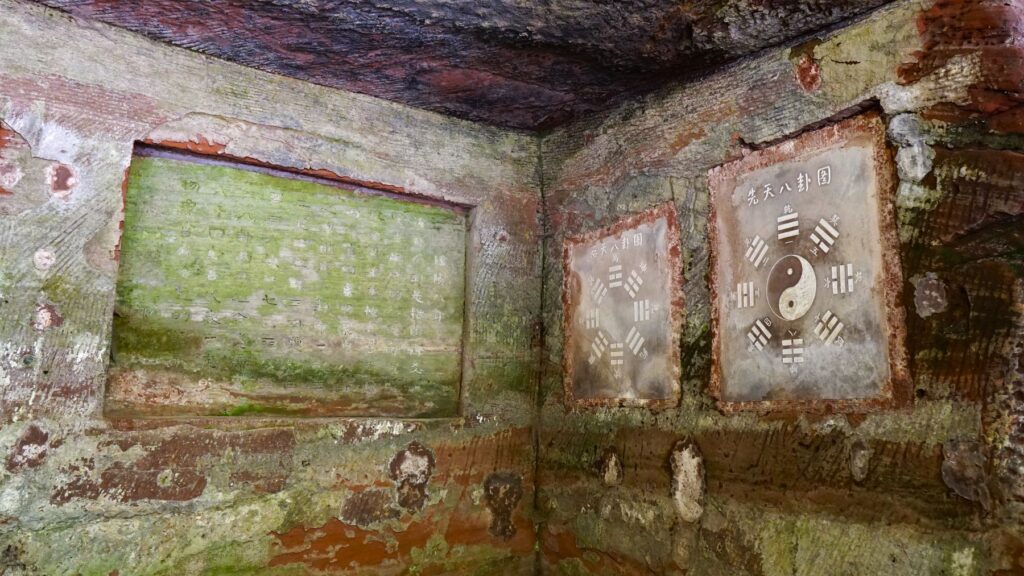
- Jiuqu Plank Path (九曲栈道 Jiǔ Qū Zhàn Dào)
Clinging to the cliff, this zigzagging walkway offers immersive views of the three rivers merging below—watch how the Minjiang’s emerald waters clash with the Dadu’s silted gold and the Qingyi’s light blue, creating swirling whirlpools.

- Buddha’s Head Plaza
Standing level with the Buddha’s 14.7-meter-high face, you’ll have the best facial views: half-closed eyes, 7-meter-long ears, and 1,021 coiled hair buns. His slight smile greets travelers from miles away.
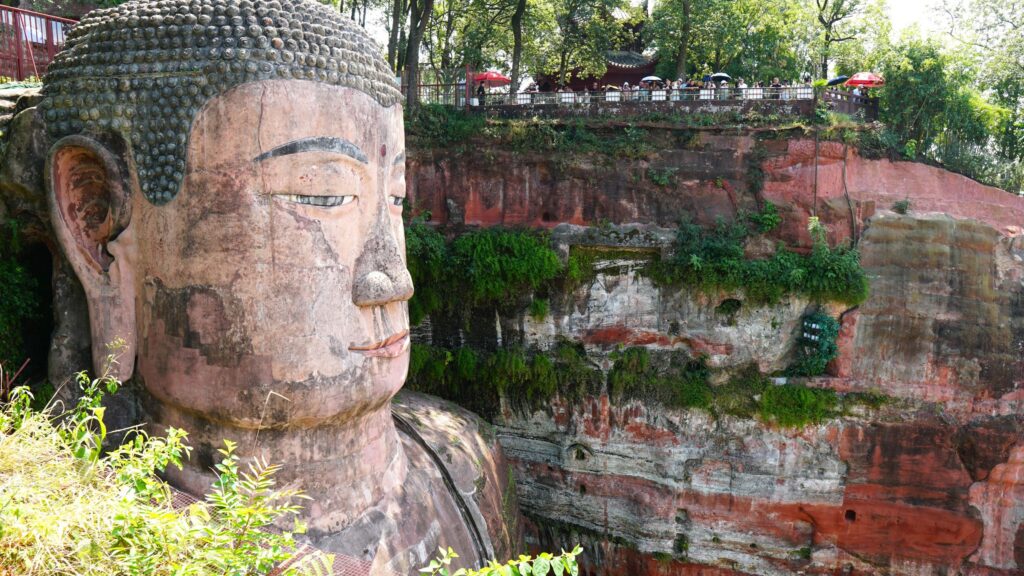
- Buddha’s Feet
Touch the massive 8.5m-wide toes, where pilgrims have left handprints for centuries. The toes alone are taller than most people!
- Lingbao Pagoda (灵宝塔 Líng Bǎo Tǎ) – a 13th-century Buddhist pagoda
- East Gate (东门 Dōng Mén) – Exit point
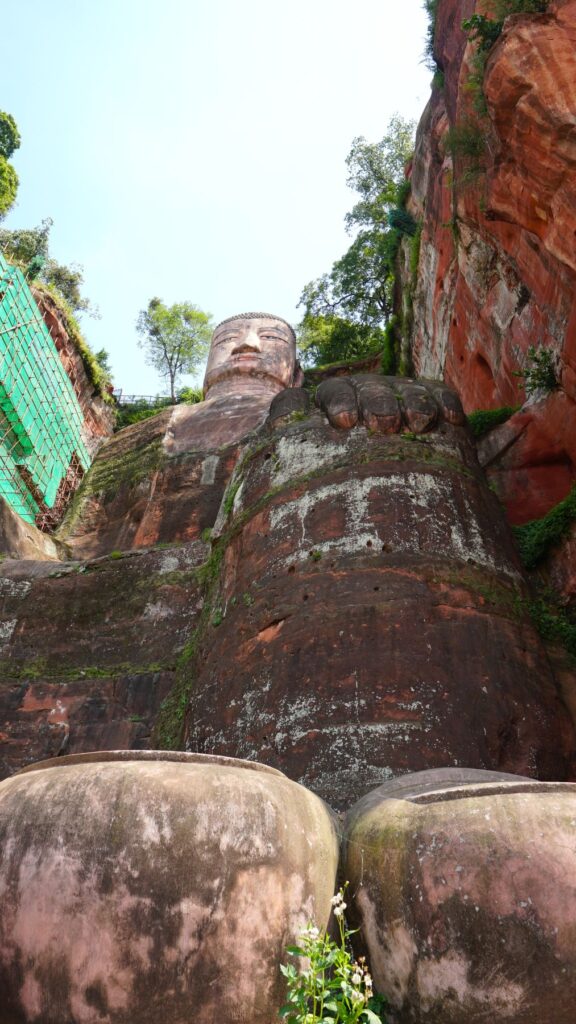
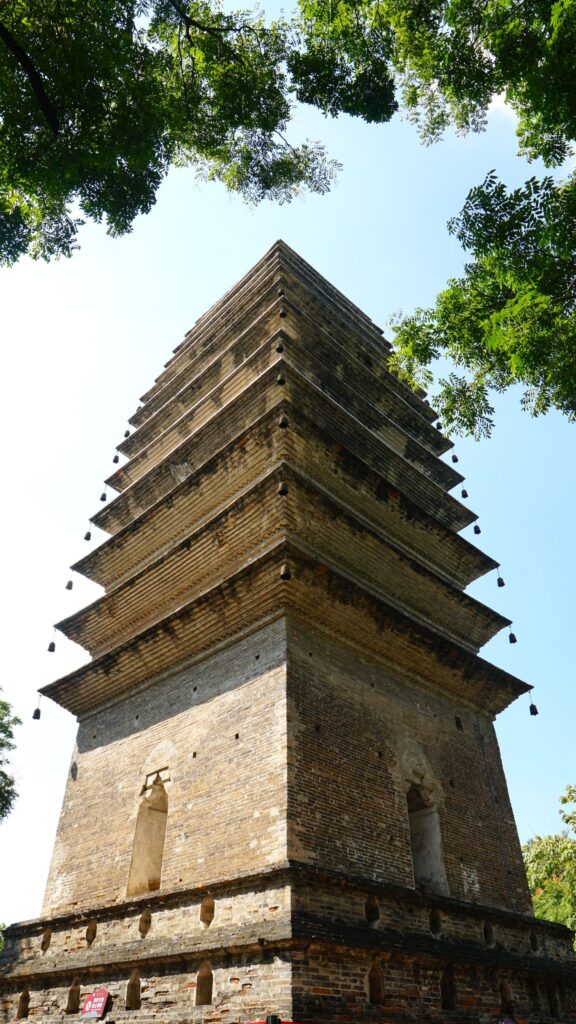
Fun Facts About the Buddha
A Buddha Built to Calm the Waters
Construction was initiated by a compassionate monk named Hai Tong (海通). He envisioned a mighty Buddha that would both bless the region and calm the turbulent waters that often wrecked passing boats.
This idea was both spiritual and practical, as the excess stone hewn from the cliff would tumble into the riverbed, reducing currents.
Ancient Drainage System
Hidden channels in the Buddha’s hair, robe, and behind both ears form a sophisticated drainage system for moisture control and ventilation— a 1,200 years of anti-erosion technique!
Hidden Chamber Mystery
In 1962, a secret room was found in the Buddha’s chest—rumored to hold treasures.
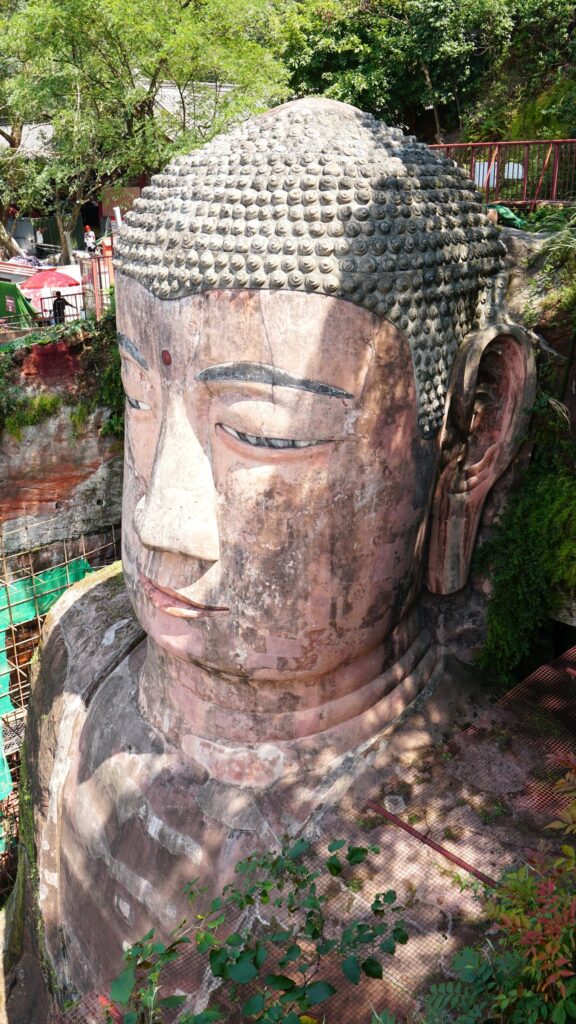
More Visitor Tips
- Best Time to Visit: May-November (pleasant weather)
- Peak Season: April 1 – October 7 (expect crowds)
- Ticket Advice: Try to book boat/hike tickets 1 day in advance, especially during Chinese holidays.
Leshan Food
Many say that you haven’t truly experienced Sichuan if you haven’t eaten in Leshan—a city so legendarily delicious that locals joke you can “eat 18 meals a day” here.
Famed as Sichuan’s underrated food capital, Leshan’s food is about diverse flavors, irresistible aroma and generations-old recipes. Popular food streets include Zhanggongqiao (张公桥), Shangzhongshun (上中顺), or Jiaxing Road (嘉兴路), where you can find all the iconic dishes.
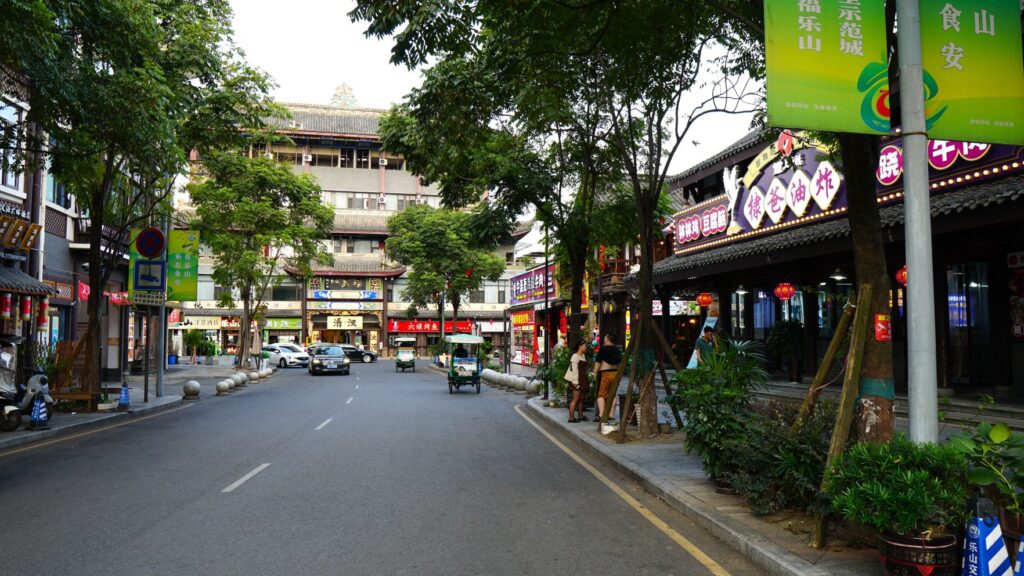
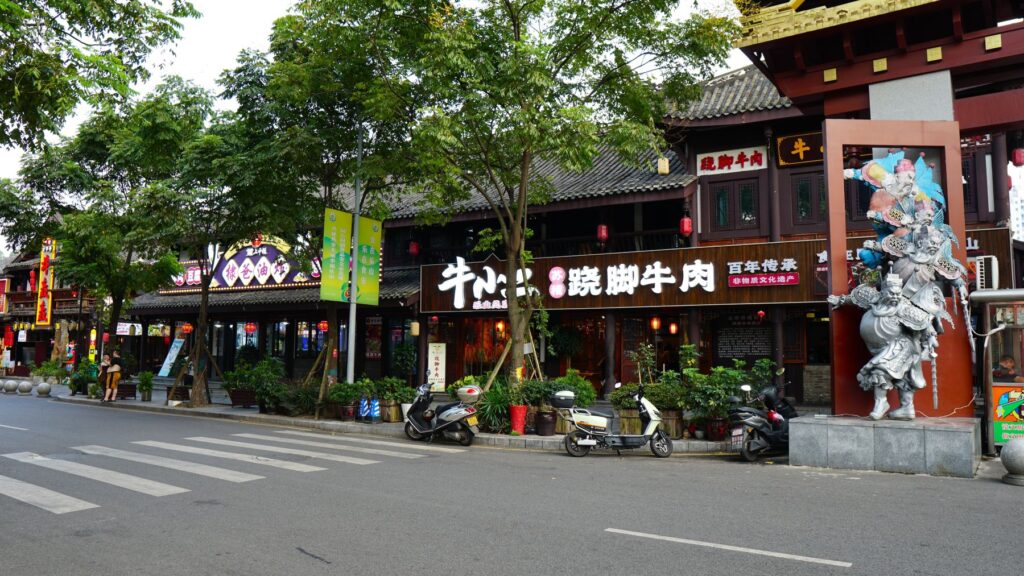
Qiaojiao Niurou (跷脚牛肉) – “foot-stomping” beef pot

It features tender beef and offal poached in a bone broth, with ultra-thin beef slices, cooked in seconds, and served with a chili dip that’s smoky and spicy but not overwhelming.
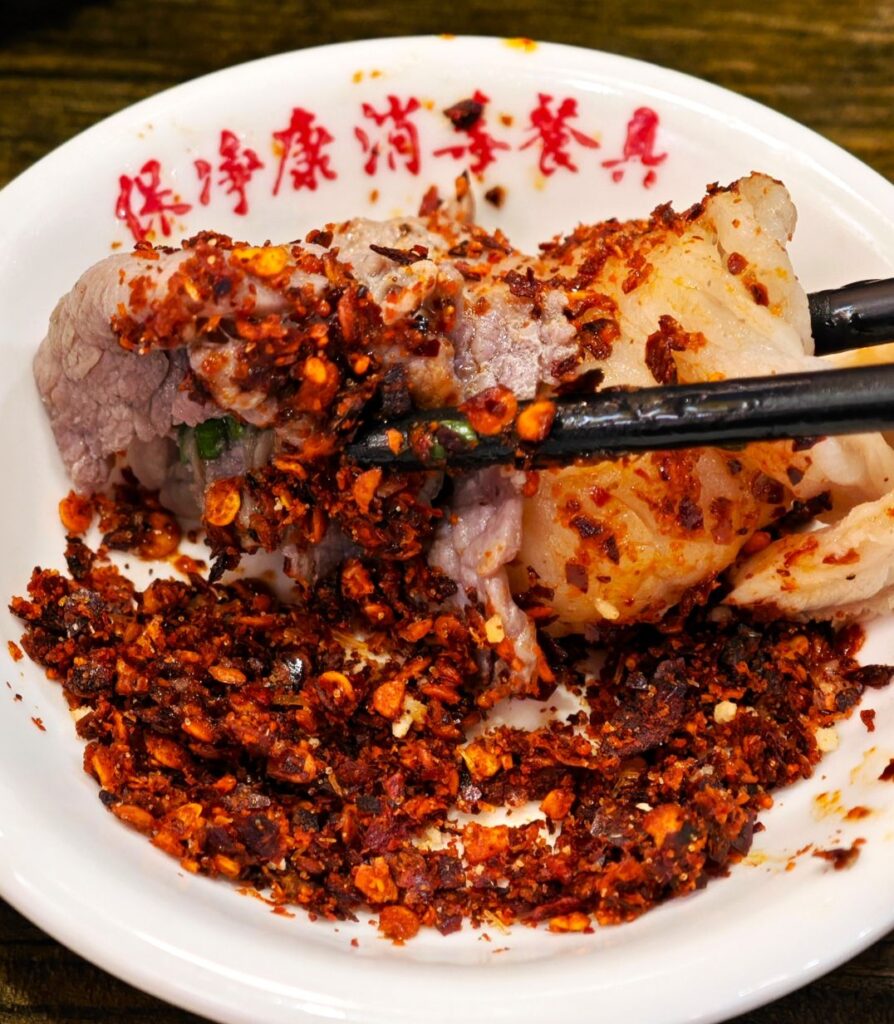
The meat is silky-soft, the tripe has a nice chew, and the broth – savory, herbal, and simmered for hours with star anise, ginger, and Sichuan peppercorns – has a taste so rich and clean that you’ll want to drink every last drop.
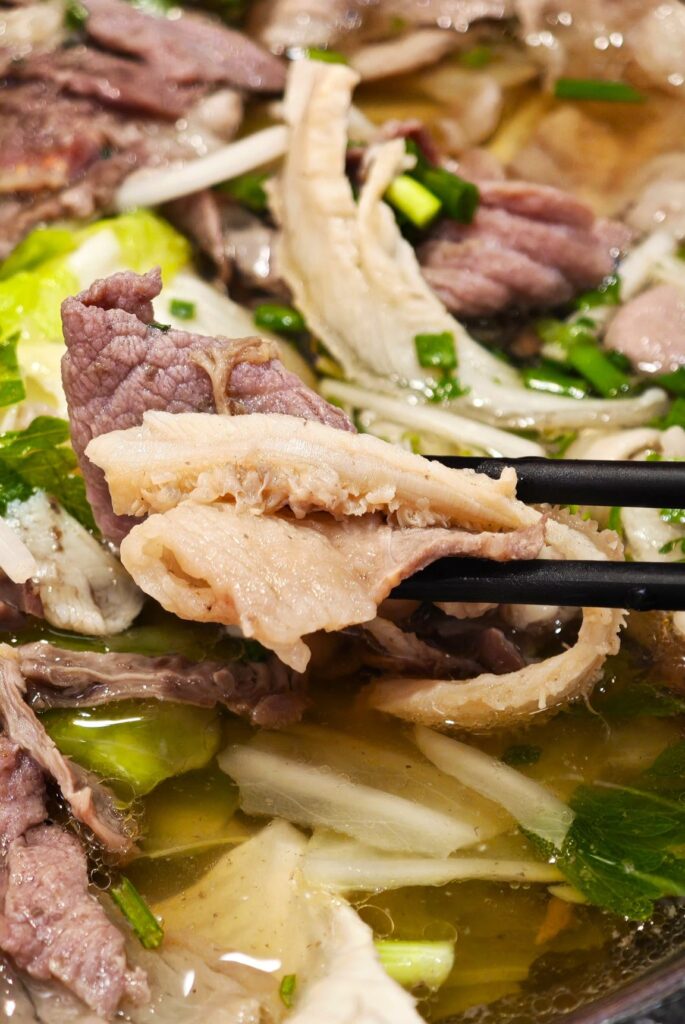
Bobojii (钵钵鸡) – cold meat & veggie skewers
Juicy meat and crunchy veggies soaked in a pool of spicy chili oil or numbing Sichuan pepper sauce; each bite glazed in sesame seeds.
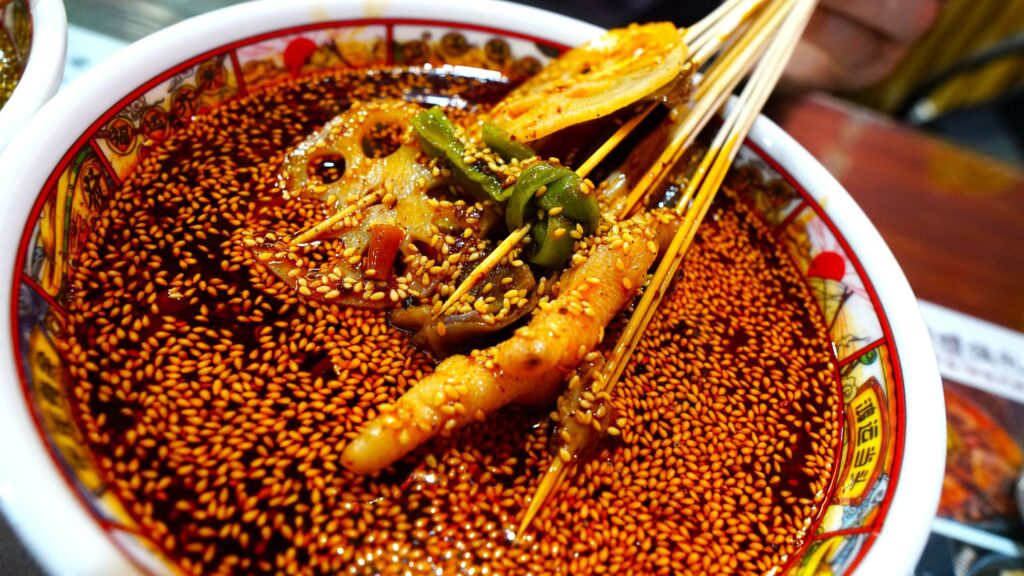
The spicy version is with garlicky, chili-laden oil that clings to every bite. And the numbing version pleases with a tingling, floral Sichuan pepper marinade and a hint of sweetness – super addictive!
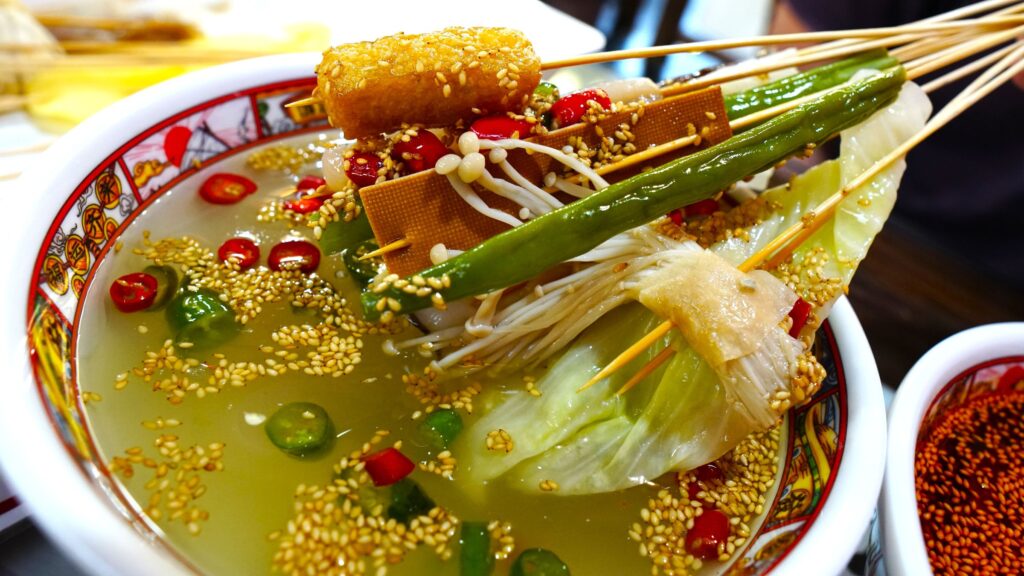
Sweet Skin Duck (甜皮鸭) – crispy, caramelized, roasted duck
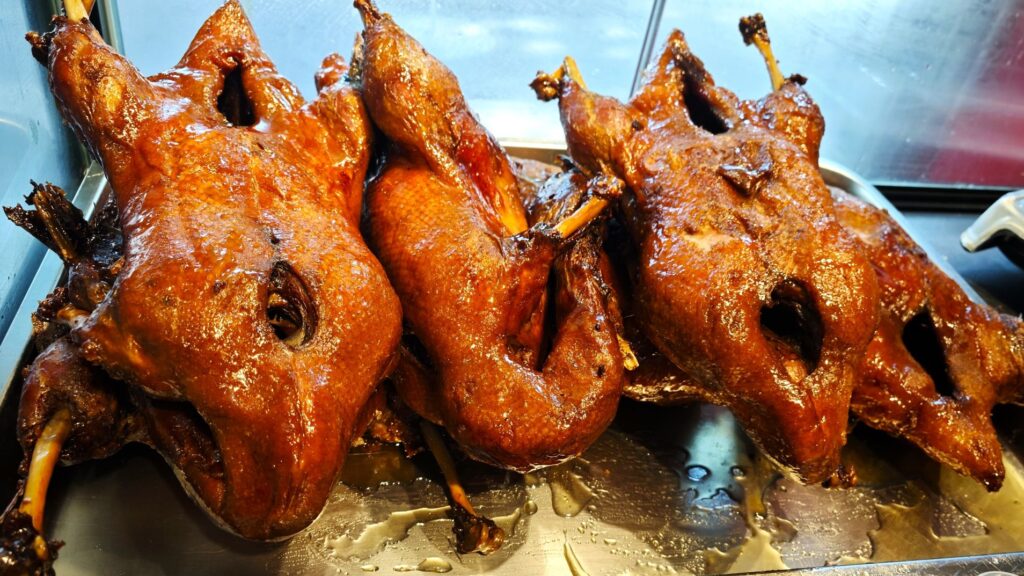
It’s a must-try. The thin skin is glass-crisp, lacquered in a light malt sugar glaze – it shatters with a delicate sweetness giving way to juicy, fragrant meat so tender and silky, it rivals Beijing roast duck.

The fat renders perfectly, so each bite is luxurious but not greasy.
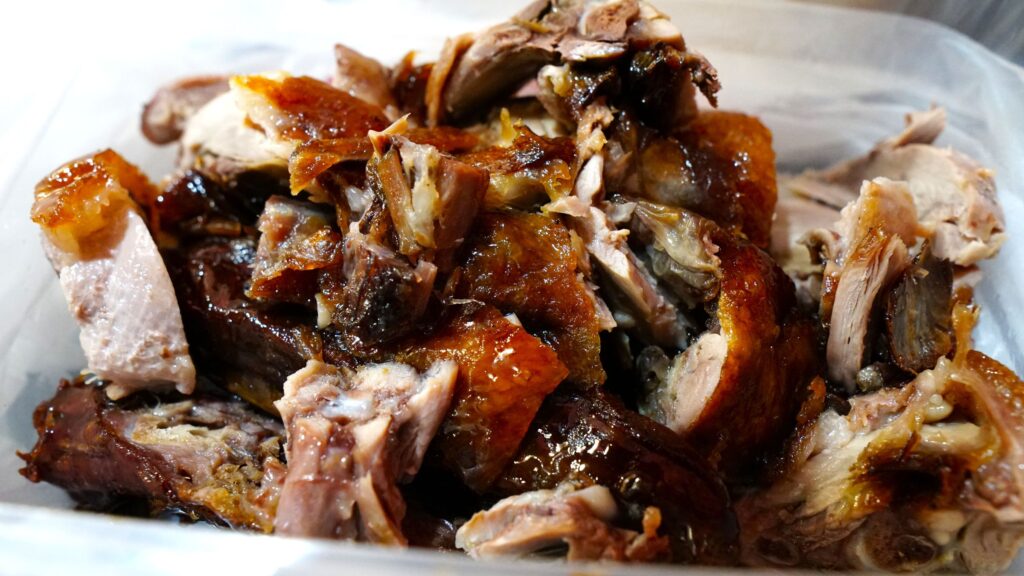
Pea Noodles (豌杂面) – pea mush noodles
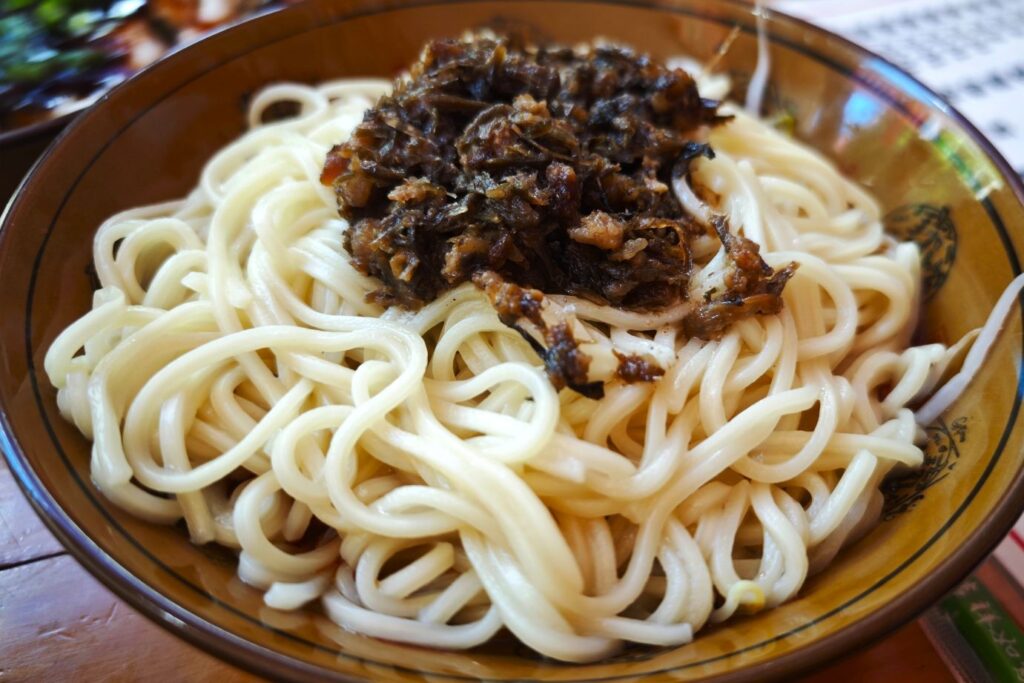
It’s a comfort staple in Leshan. The golden-yellow peas are simmered into a velvety, almost creamy paste that melts like butter into the noodles.
A fragrant dressing of chili oil, toasted garlic, and sour, bright yacai (pickled mustard greens) coats every strand. Mix it well until the pea mash becomes one with the noodles and start slurping!
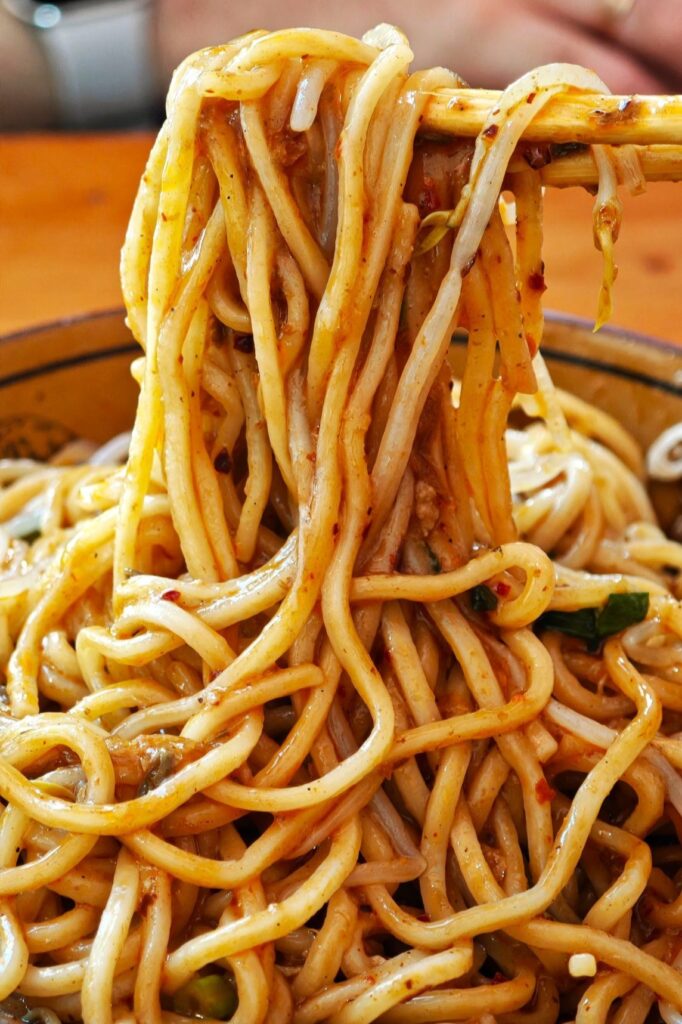
Leshan Tofu Pudding (豆腐脑)

Unlike sweet versions, this savory tofu custard is topped with chili oil, peanuts, pickles, and spring onions. It’s silky-smooth, almost like fluffy scrambled eggs, with spicy, nutty, and slightly sour flavor from fermented veggies.
Leshan Rice Wine (乐山米酒) – mild (~3%) locally brewed rice wine
This lightly fermented rice wine is fizzy, floral, and mellow. It has a light sweetness with a hint of tang.
You get a honeyed sparkle of fermented rice grains, along with comforting chew of small, glutinous rice balls floating in the wine. It’s a clean, refreshing finish to a flavorful meal.

Saying good-bye to the serene gaze of the giant Buddha, we’re looking ahead to our next trip, where we’ll wander the poetic bamboo forests of Du Fu’s Thatched Cottage, check out the modern sides of Chengdu (Chunxi Road & TaiKooLi), and taste the traditional nine-grid hotpot. So stretch the pants – Chengdu, here we come again!
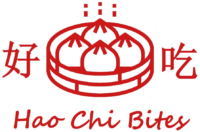
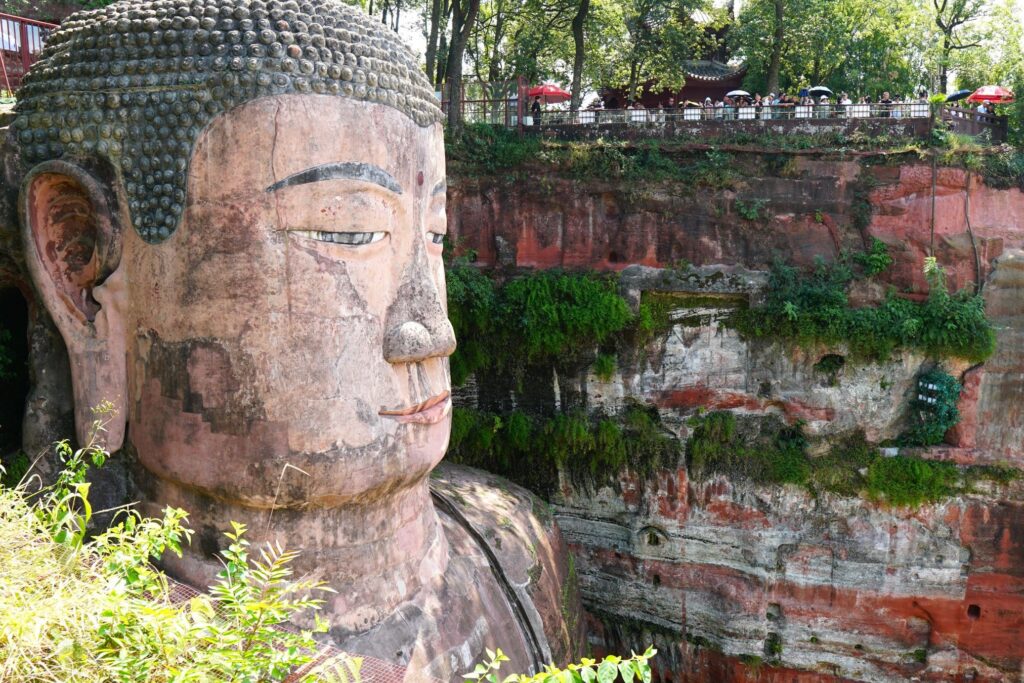
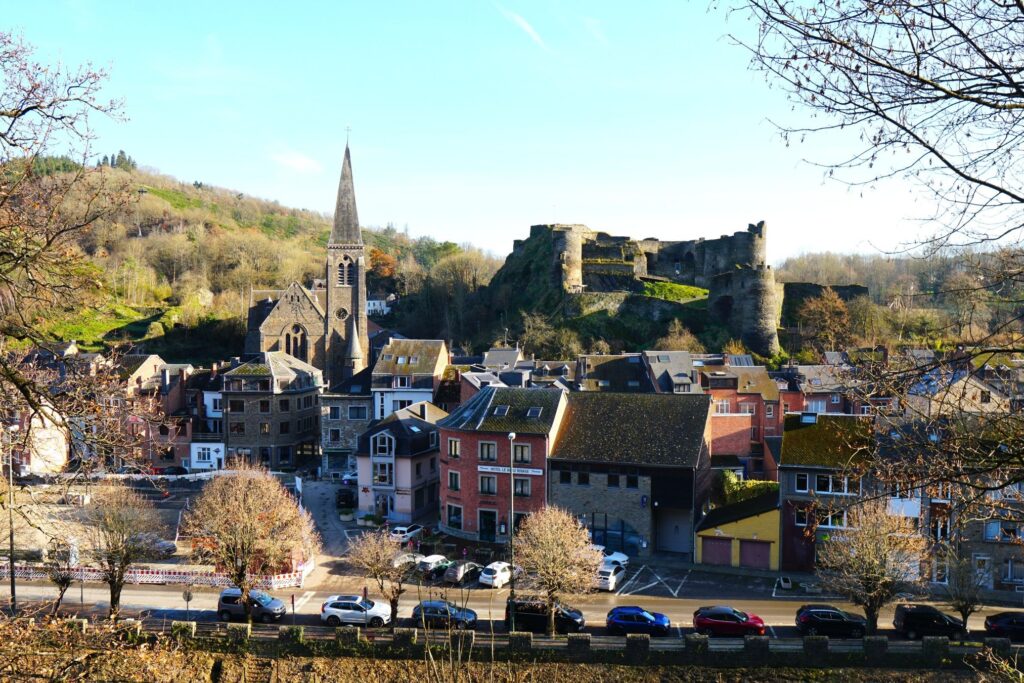


Hi, thanks so much for your post! It’s really informative! Could you also visit the Buddha in the evening? I saw a light show with the Buddha at night online, but you mentioned it’s only open during the day?
Hi Chloe, thanks for your question! You actually can visit with a night ticket, but there might be some limitations since certain areas are only open during the day. On the plus side, it’s likely to be less crowded than during the day.
Thanks for the update! This statue is absolutely impressive!
Thanks for the detailed guide! You mentioned that the boat cruise takes around 30 minutes. Do you happen to know how long the Buddha is visible during the ride? Just wondering how much time we’ll have for photos and everything.
When the boat gets close to the Giant Buddha and reaches the best viewing angle, it usually stops for about 5 minutes so visitors can take photos. Of course, you can also take pictures from the side or from farther away during the rest of the ride.
Thanks for your post! Wow, the info you shared is really helpful—I wish I had read it before my trip to Chengdu. I’ll visit the city again this/next year, and I’d love to check out Leshan next time if I get a chance.
Aside from the Giant Buddha, I’m wondering if there’s anything else worth seeing in the city?
In Leshan, you can also visit Wuyou Temple and Suxi Town. If you have time to go a bit farther, I recommend visiting Mount Emei and the Thousand Buddha Cliff—both are UNESCO World Heritage Sites. Have a great trip!
Thanks for your post! The pictures look amazing, and the information you shared is really helpful!
Many people have claimed to have seen the strange phenomenon of the Buddha “closing its eyes and shedding tears.”
This was often explained as a sign that a great disaster was coming.
Now, I think it might just be due to the drainage system built into the statue. Very interesting!